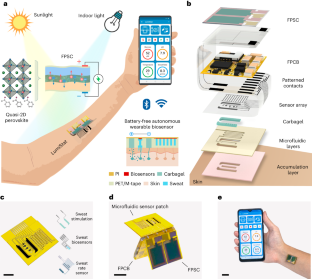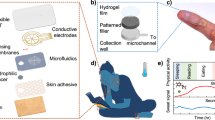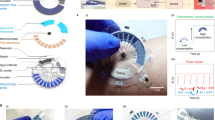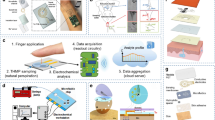Abstract
Wearable sweat sensors can potentially be used to continuously and non-invasively monitor physicochemical biomarkers that contain information related to disease diagnostics and fitness tracking. However, the development of such autonomous sensors faces a number of challenges including achieving steady sweat extraction for continuous and prolonged monitoring and addressing the high power demands of multifunctional and complex analysis. Here we report an autonomous wearable biosensor that is powered by a perovskite solar cell and can provide continuous and non-invasive metabolic monitoring. The device uses a flexible quasi-two-dimensional perovskite solar cell module that provides ample power under outdoor and indoor illumination conditions (power conversion efficiency exceeding 31% under indoor light illumination). We show that the wearable device can continuously collect multimodal physicochemical data—glucose, pH, sodium ion, sweat rate and skin temperature—across indoor and outdoor physical activities for over 12 h.
This is a preview of subscription content, access via your institution
Access options
Access Nature and 54 other Nature Portfolio journals
Get Nature+, our best-value online-access subscription
$29.99 / 30 days
cancel any time
Subscribe to this journal
Receive 12 digital issues and online access to articles
$119.00 per year
only $9.92 per issue
Buy this article
- Purchase on Springer Link
- Instant access to full article PDF
Prices may be subject to local taxes which are calculated during checkout




Similar content being viewed by others
Data availability
All the raw and analysed datasets generated during the study are available from the corresponding authors on request. Source data are provided with this paper.
References
Kim, J., Campbell, A. S., de Ávila, B. E.-F. & Wang, J. Wearable biosensors for healthcare monitoring. Nat. Biotechnol. 37, 389–406 (2019).
Ray, T. R. et al. Bio-integrated wearable systems: a comprehensive review. Chem. Rev. 119, 5461–5533 (2019).
Yang, Y. & Gao, W. Wearable and flexible electronics for continuous molecular monitoring. Chem. Soc. Rev. 48, 1465–1491 (2019).
Heikenfeld, J. et al. Accessing analytes in biofluids for peripheral biochemical monitoring. Nat. Biotechnol. 37, 407–419 (2019).
Libanori, A., Chen, G., Zhao, X., Zhou, Y. & Chen, J. Smart textiles for personalized healthcare. Nat. Electron. 5, 142–156 (2022).
Someya, T., Bao, Z. & Malliaras, G. G. The rise of plastic bioelectronics. Nature 540, 379–385 (2016).
Bariya, M., Nyein, H. Y. Y. & Javey, A. Wearable sweat sensors. Nat. Electron. 1, 160–171 (2018).
Gao, W. et al. Fully integrated wearable sensor arrays for multiplexed in situ perspiration analysis. Nature 529, 509–514 (2016).
Choi, J., Ghaffari, R., Baker, L. B. & Rogers, J. A. Skin-interfaced systems for sweat collection and analytics. Sci. Adv. 4, eaar3921 (2018).
Bandodkar, A. J. et al. Battery-free, skin-interfaced microfluidic/electronic systems for simultaneous electrochemical, colorimetric, and volumetric analysis of sweat. Sci. Adv. 5, eaav3294 (2019).
Nyein, H. Y. Y. et al. Regional and correlative sweat analysis using high-throughput microfluidic sensing patches toward decoding sweat. Sci. Adv. 5, eaaw9906 (2019).
Kim, S. et al. Soft, skin-interfaced microfluidic systems with integrated immunoassays, fluorometric sensors, and impedance measurement capabilities. Proc. Natl Acad. Sci. USA 117, 27906–27915 (2020).
Son, D. et al. Multifunctional wearable devices for diagnosis and therapy of movement disorders. Nat. Nanotechnol. 9, 397–404 (2014).
Niu, S. et al. A wireless body area sensor network based on stretchable passive tags. Nat. Electron. 2, 361–368 (2019).
Sempionatto, J. R. et al. An epidermal patch for the simultaneous monitoring of haemodynamic and metabolic biomarkers. Nat. Biomed. Eng. 5, 737–748 (2021).
Emaminejad, S. et al. Autonomous sweat extraction and analysis applied to cystic fibrosis and glucose monitoring using a fully integrated wearable platform. Proc. Natl Acad. Sci. USA 114, 4625–4630 (2017).
Lee, H. et al. Wearable/disposable sweat-based glucose monitoring device with multistage transdermal drug delivery module. Sci. Adv. 3, e1601314 (2017).
Yang, Y. et al. A laser-engraved wearable sensor for sensitive detection of uric acid and tyrosine in sweat. Nat. Biotechnol. 38, 217–224 (2020).
Torrente-Rodríguez, R. M. et al. Investigation of cortisol dynamics in human sweat using a graphene-based wireless mHealth system. Matter 2, 921–937 (2020).
Kwon, K. et al. An on-skin platform for wireless monitoring of flow rate, cumulative loss and temperature of sweat in real time. Nat. Electron. 4, 302–312 (2021).
Sonner, Z., Wilder, E., Gaillard, T., Kasting, G. & Heikenfeld, J. Integrated sudomotor axon reflex sweat stimulation for continuous sweat analyte analysis with individuals at rest. Lab Chip 17, 2550–2560 (2017).
Simmers, P., Li, S. K., Kasting, G. & Heikenfeld, J. Prolonged and localized sweat stimulation by iontophoretic delivery of the slowly-metabolized cholinergic agent carbachol. J. Dermatol. Sci. 89, 40–51 (2018).
Yu, Y. et al. Biofuel-powered soft electronic skin with multiplexed and wireless sensing for human-machine interfaces. Sci. Robot. 5, eaaz7946 (2020).
Song, Y. et al. Wireless battery-free wearable sweat sensor powered by human motion. Sci. Adv. 6, eaay9842 (2020).
Yin, L. et al. A passive perspiration biofuel cell: high energy return on investment. Joule 5, 1888–1904 (2021).
Yin, L. et al. A self-sustainable wearable multi-modular E-textile bioenergy microgrid system. Nat. Commun. 12, 1542 (2021).
Xu, F. et al. Scalable fabrication of stretchable and washable textile triboelectric nanogenerators as constant power sources for wearable electronics. Nano Energy 88, 106247 (2021).
Park, S. et al. Self-powered ultra-flexible electronics via nano-grating-patterned organic photovoltaics. Nature 561, 516–521 (2018).
Meng, K. et al. A wireless textile-based sensor system for self-powered personalized health care. Matter 2, 896–907 (2020).
Polyzoidis, C., Rogdakis, K. & Kymakis, E. Indoor perovskite photovoltaics for the internet of things—challenges and opportunities toward market uptake. Adv. Energy Mater. 11, 2101854 (2021).
Mathews, I., King, P. J., Stafford, F. & Frizzell, R. Performance of III–V solar cells as indoor light energy harvesters. IEEE J. Photovolt. 6, 230–235 (2016).
Espinosa, N., Hösel, M., Angmo, D. & Krebs, F. C. Solar cells with one-day energy payback for the factories of the future. Energy Environ. Sci. 5, 5117–5132 (2012).
Roy, P., Kumar Sinha, N., Tiwari, S. & Khare, A. A review on perovskite solar cells: evolution of architecture, fabrication techniques, commercialization issues and status. Sol. Energy 198, 665–688 (2020).
Gao, F., Zhao, Y., Zhang, X. & You, J. Recent progresses on defect passivation toward efficient perovskite solar cells. Adv. Energy Mater. 10, 1902650 (2020).
Green, M. A. et al. Solar cell efficiency tables (version 58). Prog. Photovolt. Res. Appl. 29, 657–667 (2021).
Zheng, H. et al. Emerging organic/hybrid photovoltaic cells for indoor applications: recent advances and perspectives. Sol. RRL 5, 2100042 (2021).
Hashemi, S. A., Ramakrishna, S. & Aberle, A. G. Recent progress in flexible–wearable solar cells for self-powered electronic devices. Energy Environ. Sci. 13, 685–743 (2020).
Zhao, J. et al. A fully integrated and self-powered smartwatch for continuous sweat glucose monitoring. ACS Sens. 4, 1925–1933 (2019).
Mallick, A. & Visoly-Fisher, I. Pb in halide perovskites for photovoltaics: reasons for optimism. Mater. Adv. 2, 6125–6135 (2021).
Hamann, D. et al. Jewellery: alloy composition and release of nickel, cobalt and lead assessed with the EU synthetic sweat method. Contact Derm. 73, 231–238 (2015).
World Health Organization. Regional Office for Europe (2000). Air quality guidelines for Europe, 2nd ed. World Health Organization. Regional Office for Europe; https://apps.who.int/iris/handle/10665/107335
Hailegnaw, B. et al. Inverted (p–i–n) perovskite solar cells using a low temperature processed TiOx interlayer. RSC Adv. 8, 24836–24846 (2018).
Venkateswararao, A., Ho, J. K. W., So, S. K., Liu, S.-W. & Wong, K.-T. Device characteristics and material developments of indoor photovoltaic devices. Mater. Sci. Eng. R Rep. 139, 100517 (2020).
Acknowledgements
This project was supported by the National Institutes of Health grants R01HL155815 and R21DK13266, Office of Naval Research grants N00014-21-1-2483 and N00014-21-1-2845, the Translational Research Institute for Space Health through NASA NNX16AO69A, National Science Foundation grant 2145802 (to W.G.) and the European Research Council Starting Grant ‘GEL-SYS’ under grant agreement no. 757931 (to M.K.). S.D. would like to acknowledge the Marshall Plan Foundation that provided financial support for the three months of research visit to California Institute of Technology that initiated this work.
Author information
Authors and Affiliations
Contributions
W.G., J.M., M.K. and S.D. initiated the concept and designed the studies. J.M. and S.D. led the experiments and collected the overall data. J.R.S., Y.S., B.H., C.X., Y.Y. and S.S. contributed to the wearable device characterization, validation and sample analysis. B.H., C.P., L.L., M.S. and S.S. contributed to the solar module development, fabrication and characterization. S.D., B.H., J.F.S. and C.S. contributed to the experimental design and characterization of Pb leakage test for the solar cell module. E.S.S. contributed to the cell viability and metabolic activity characterization. J.M., S.D., W.G. and M.K. co-wrote the paper. All authors contributed to the data analysis and provided feedback on the manuscript.
Corresponding authors
Ethics declarations
Competing interests
The authors declare no competing interests.
Peer review
Peer review information
Nature Electronics thanks Roozbeh Ghaffari, Norbert Radacsi and the other, anonymous, reviewer(s) for their contribution to the peer review of this work.
Additional information
Publisher’s note Springer Nature remains neutral with regard to jurisdictional claims in published maps and institutional affiliations.
Supplementary information
Supplementary Information
Supplementary Notes 1–3, Figs. 1–35, Tables 1–5 and references 1–15.
Supplementary Video 1
Demonstration of the wearable sensor mobile application.
Supplementary Video 2
Light-powered iontophoresis-based prolonged microfluidic sweat sampling and sweat rate monitoring at rest.
Source data
Source Data Fig. 4
Source data for human studies (Fig. 4).
Rights and permissions
Springer Nature or its licensor (e.g. a society or other partner) holds exclusive rights to this article under a publishing agreement with the author(s) or other rightsholder(s); author self-archiving of the accepted manuscript version of this article is solely governed by the terms of such publishing agreement and applicable law.
About this article
Cite this article
Min, J., Demchyshyn, S., Sempionatto, J.R. et al. An autonomous wearable biosensor powered by a perovskite solar cell. Nat Electron 6, 630–641 (2023). https://doi.org/10.1038/s41928-023-00996-y
Received:
Accepted:
Published:
Issue Date:
DOI: https://doi.org/10.1038/s41928-023-00996-y
This article is cited by
-
Towards a digitally connected body for holistic and continuous health insight
Communications Materials (2024)
-
Connecting the work of scientists, engineers and industry
Nature Electronics (2024)
-
A wearable aptamer nanobiosensor for non-invasive female hormone monitoring
Nature Nanotechnology (2024)
-
Photonics-powered augmented reality skin electronics for proactive healthcare: multifaceted opportunities
Microchimica Acta (2024)
-
An Integrated Bifunctional Pressure‒Temperature Sensing System Fabricated on a Breathable Nanofiber and Powered by Rechargeable Zinc–Air Battery for Long-Term Comfortable Health Care Monitoring
Advanced Fiber Materials (2024)



